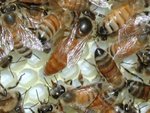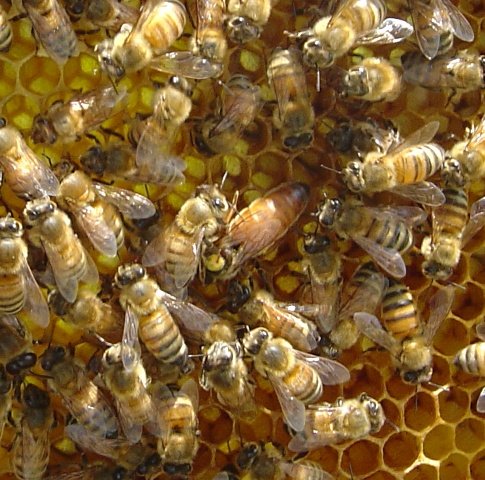I "must" find something to pass away the winter days without the bees……
MEAD…
.
.

.
.
Right: Lemon and orange zest and juice along with 12 pounds of honey.
.
.
.
.
.
.
.
.
.
.
Honey was for thousands of years the main sweetening agent known to humans.
Life, Courage, Wisdom, and strength were believed to be provided by honey. The Bible, Hinduism, Aristotle, Virgil, Celtics all echo the praises of honey.
.
 .
.Left: Zest and spices ready to be boiled in the "must"
.
.
.
.
.
There are many types of mead. Dry, Sweet, Wine like, Beer like, mixed with fruit (Melomel), mixed with herbs (Pyment, Hippocras, Metheglin, Cyser).
Right: Pure water and spices boiling to create the "must". Once cooled the honey and yeast will be added and fermentation will begin!
.In its simplest form, honey is mixed with water and fermented. The amount of honey mixed in proportion to the water controls the amount of alcohol that can be produced in the final drink. It also controls how sweet the drink will be. In this simple form the flavor of the mead will be created by two things… the flavor of the honey used, and any flavors added by the particular strain of yeast used to ferment the must (mixture).
.
Left. The empty fermentation bucket after two weeks of fermentation. You can see how mudy the must looks from the yeast.
Meads will taste different if different types of honey are used. A wild flower honey will impart a different flavor to the mead than say a cranberry or orange blossom honey. A champagne yeast will have a different flavor than a merlot yeast.
There are hundreds if not thousands of recipes for mead. Choosing one is difficult.Back in 1978 I made my first batch of mead. It was just a simple honey, water, yeast mixture. It fermented, bottled, and aged. At just the right moment a bottle was opened and tasted.
Reminded me of kerosene!...... Others liked it.
This year I created my own recipe, actually a combination of two that seamed interesting. I would be using honey from our hives of course. Cape Cod Wild Flower Honey to be exact. I wanted a spiced fruity mead. More of a Metheglin I would say.
I started with orange and lemon zest, and juice, a touch of chamomile, cinnamon, ginger, cloves, yeast nutrient, and tannin in a muslin bag. Boiled in water for 15 minutes, and then rested the must for 15 minute. The must was added to a sterilized fermentation bucket along with 12 pounds of honey. Once the must was cool the specific gravity of the must was taken and champagne yeast was added and fermentation started within hours.
.
Right: The "must" is "racked" into a secondary fermentation container fitted with an air lock. The air lock protects the mead from wild yeasts or other thinks that could ruin the mead.
.
.
.
.
.
Why check the specific gravity you ask?
By taking a specific gravity reading prior to fermentation, and comparing it to a reading after fermentation is complete allows us to calculate how much alcohol was produced in the mead. An alcohol content between 12% and 13% will preserve the mead and keep it from turning bad. The bees would not be happy if all that honey went to waste now would they!
The alcohol, being produced, is a byproduct of the fermentation process. Yeast is a living organism that consumes sugar and nutrients from the must, and produces alcohol and carbon dioxide as waste. The carbon dioxide comes out of the must as bubbles (gas).
Its fun to watch the mead bubble away. Especially knowing that for every tiny bubble of carbon dioxide, an equal amount of alcohol is produced.
Eventually the yeast runs out of sugar (food) to eat, and the fermentation process is complete.
Now we will have to wait for the mead to “clear” which means all the yeast settles to the bottom of the container and a clear drinkable liquid can be bottled. Mead takes a couple of months to clear.
Left: You can see the bubbles created by the yeast. Toasted oak chips have been added to give the mead an oak cask flavor.
.
.
.
.
.
.
.
Once bottled, the mead will have to age for a year or so before it will taste good enough to drink.
I don’t think I will be able to wait that long though!
Good Mead web pages:
The Joy Of Mead:
http://www.stormthecastle.com/mead/index.htm
Eckraus:
http://www.eckraus.com/wine-making-mead-honey.html
The wine making home page:










No comments:
Post a Comment